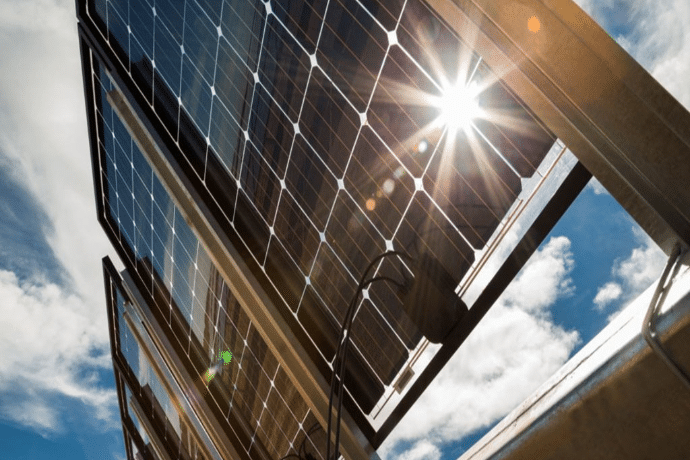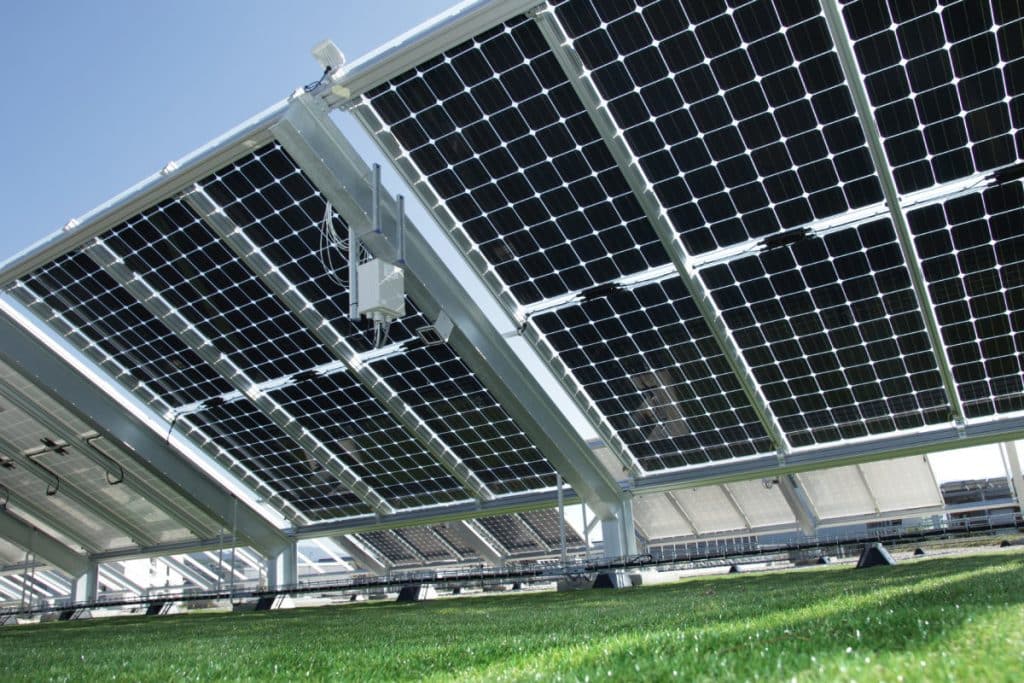Solar panels are a great way to generate clean and renewable energy for your home or business. But did you know that there are different types of solar panels that can offer different benefits? In this blog post, we will introduce you to bifacial solar panels, a new product trend in the solar industry that can capture sunlight on both their front and back sides. We will explain what they are, how they work, their pros and cons, their development trends, and whether they are worth buying.
What are bifacial solar panels?
Bifacial solar panels are solar panels that have solar cells on both sides. Bifacial solar modules can be effective in residential applications like pergolas and ground-mounted systems. This enables them to absorb light from the back as well as the front, unlike traditional (monofacial) solar panels that only capture sunlight on one side. This means that bifacial solar panels can generate more electricity from the same amount of sunlight, especially if they are installed in a way that allows light to reflect into the back of the panel.
Bifacial solar panels are not new. In fact, the first solar cells produced by Bell Laboratories in 1954 were bifacial. However, they have not been widely adopted until recently, due to their higher cost and more specific installation requirements.
How do bifacial solar panels work?
Bifacial solar panels work by using crystalline silicon to absorb sunlight and convert it into an electric current, just like monofacial solar panels. The difference is that they are made of transparent glass, which lets some of the light pass through and reflect off the surface below. To further increase the amount of light passing through, they use glass instead of metal frames or grid lines to hold them in place.
The backside of a bifacial solar panel usually shares its circuitry with the front side, thus increasing the efficiency without increasing the wiring. The amount of electricity generated by each bifacial panel depends on several factors, such as the angle of the panel, the reflectivity of the surface below, the weather conditions, and the time of day.
What are the advantages and disadvantages of bifacial solar panels?
- Bifacial solar panels have several advantages over mono-facial solar panels:
- Generate up to 9% more electricity than mono facial panels, which means fewer panels need to be installed and less space is required.
- Lower working temperatures, which improves their performance and lifespan, since solar PV technology is less efficient at higher temperatures.
- Don’t need to be grounded, since they lack metal frames that might potentially conduct electricity.
- More durable and often comes with longer warranties (30 rather than 25 years for mono facial panels).
- More efficient in cloudy climates or anywhere there is less direct sunlight and more diffuse radiation.
However, bifacial solar panels also have some drawbacks:
- More expensive than monofacial panels, due to their higher manufacturing cost and lower availability.
- Require more careful installation and maintenance, since they need to be elevated and angled away from a mounting surface to allow light to reflect into the back of the panel. They may also need additional equipment like solar tracking systems or ground mounts.
- May not be suitable for all types of roofs or locations, since they depend on the reflectivity of the surface below them. For example, dark or uneven surfaces may reduce their efficiency.
What are the development trends of bifacial solar panels?
Bifacial solar panels are expected to grow in popularity and market share in the coming years, as their cost decreases and their performance improves. According to a report by Wood Mackenzie, a global energy research firm, bifacial modules will account for 17% of global solar module installations by 2024. The report also predicts that China will be the largest market for bifacial modules, followed by Europe and North America.
Some of the factors that will drive the growth of bifacial solar panels include:
- Increasing demand for higher efficiency and lower levelized cost of energy (LCOE) in the solar industry.
- Development of new technologies and materials that enhance the performance and durability of bifacial modules.
- Adoption of new standards and regulations that support or incentivize bifacial installations.
- The emergence of new applications and markets for bifacial modules, such as floating solar farms or agrivoltaics.

Double-sided solar panels for commercial and utility-scale applications
Double-sided solar panels find their ideal use case in commercial and utility-scale solar installations, especially those equipped with solar trackers. In a study conducted by solar panel manufacturer LONGi in China, double-sided panels outperformed standard solar panels by generating 11% more energy in a tilted, ground-mounted solar installation. What’s even more impressive is that solar systems utilizing both double-sided panels and solar trackers produce 27% more solar energy than systems of a similar size using traditional panels.
Double-sided panels have the potential to enhance the energy output of large-scale solar installations due to their ability to capture energy on both sides. When solar panels are ground-mounted, as is common in many commercial systems, sunlight that falls on the ground beneath the panels is reflected back and can be absorbed by the rear-side solar cells. Additionally, depending on the surface below, varying amounts of light will be reflected onto the double-sided panels. Generally, lighter-colored surfaces like sand tend to reflect more sunlight compared to darker surfaces like asphalt or soil.
Are bifacial solar panels worth buying?
The answer to this question depends on your specific situation and goals. Bifacial solar panels can offer higher efficiency and lower LCOE than monofacial panels, but they also require higher upfront investment and more complex installation. Therefore, you should consider several factors before deciding whether to buy bifacial solar panels or not:
– Your budget: Bifacial solar panels are more expensive than monofacial panels, so you need to weigh the initial cost against the long-term savings.
– Your location: Bifacial solar panels perform better in areas with high albedo (reflectivity) and diffuse radiation (cloudy or snowy climates), so you need to check your local weather conditions and surface characteristics.
– Your roof type: Bifacial solar panels may not be compatible with some roof types or orientations, so you need to consult with a professional installer before choosing them.
– Your energy needs: Bifacial solar panels can generate more electricity than monofacial panels, so you need to calculate your energy consumption and production potential.
Are double-sided solar panels worth it?
Double-sided solar panels may be worthwhile for commercial and utility solar developers, but they often don’t make much sense for residential rooftop projects. The higher cost of additional required equipment means that the average homeowner may still have to pay more to install double-sided panels compared to the savings from increased efficiency. Regardless of project size, location, or other factors, comparing multiple offers is the best way to get a solar panel installation. If you are interested in double-sided solar panels, feel free to talk to a Sungold engineer
Our suggestion
Bifacial solar panels are an innovative and promising technology that can offer higher efficiency and lower LCOE than monofacial panels.
However, they also have some challenges and limitations that need to be considered before making a purchase decision. Bifacial solar panels are not a one-size-fits-all solution, but rather a tailored option that depends on your specific situation and goals.
FAQ:
Q: Are bifacial solar panels better?
A: Bifacial solar panels can be a better choice in certain situations. They offer increased efficiency and energy generation compared to monofacial panels, especially in locations with reflective surfaces like snow, water, or light-colored ground. However, their effectiveness can depend on factors like installation angle, ground cover, and local climate conditions. To determine if bifacial panels are better for your specific needs, it’s essential to consider these factors and conduct a thorough evaluation.
Q: Can you put bifacial solar panels on the roof?
A: Yes, it is possible to install bifacial solar panels on a roof. However, the effectiveness of bifacial panels on a roof depends on the design, orientation, and surroundings of the roof. Bifacial panels can capture sunlight from both the front and rear sides, but their performance may be influenced by factors like shading, roof angle, and the presence of reflective surfaces. A professional solar installer can assess your specific roof conditions and advise on the feasibility and potential benefits of using bifacial solar panels for your rooftop solar system.
Q: Which is better bifacial vs Monofacial?
A: The choice between bifacial and myofascial solar panels depends on your specific needs and the circumstances of your installation:
Bifacial Solar Panels:
1. Higher Efficiency: Bifacial panels are generally more efficient because they capture sunlight from both the front and rear sides.
2. Increased Energy Production: They generate more energy, especially in locations with reflective surfaces.
3. Varied Installation Options: Bifacial panels can be ground-mounted or installed on rooftops, but they often require additional considerations.
Monofacial Solar Panels:
1. Cost-Effective: Monofacial panels are typically more cost-effective and easier to install.
2. Simplicity: They are a straightforward and reliable choice for many standard solar installations.
3. Roof-Friendly: Monofacial panels are often preferred for rooftop installations due to their simplicity and cost-effectiveness.
The “better” choice depends on your specific goals, budget, and the environmental conditions of your location. For maximum efficiency and energy generation, bifacial panels may be preferred, but they can come at a higher cost. Monofacial panels are a practical and economical choice for many standard installations. It’s essential to consult with a solar professional to determine the best option for your situation.



























